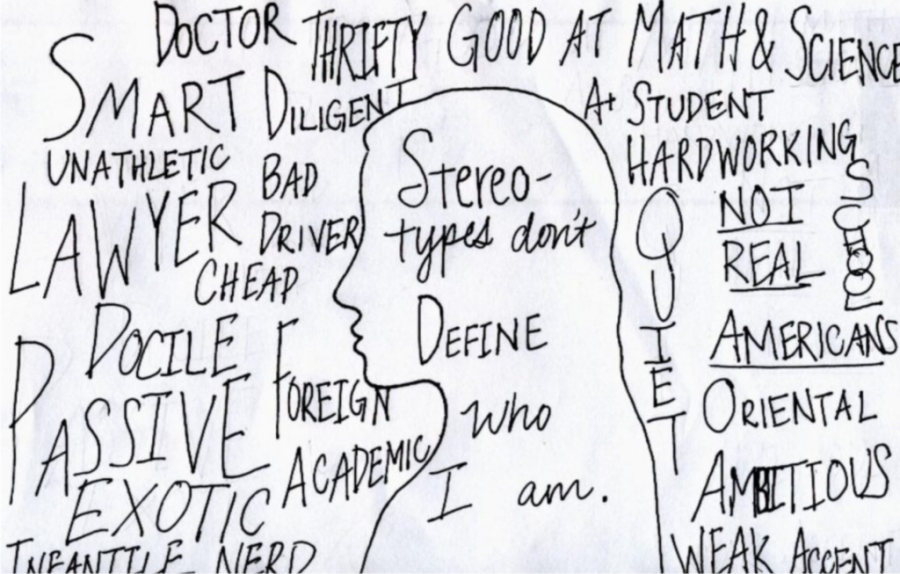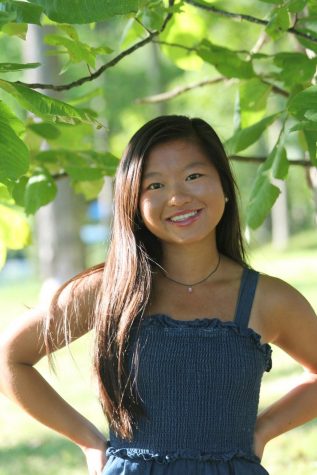Debunking the Model Minority Myth
Illustration depicting common stereotypes about Asian Americans.
January 13, 2022
The model minority myth is a concept that originated historically as a way of labeling Asian Americans as a model community of immigrants who have succeeded in the American dream. The myth states that all Asian Americans are polite, law-abiding academic prodigies who overcame discrimination.
Asian people living in the U.S. are often held up as a paragon of integration into American culture. Stereotypes abound — from mathematical whizzes to tiger moms to law-abiding doctors, lawyers, and engineers — and they paint an exceedingly favorable picture of immigrants striving and thriving. But this model minority mythology simplifies and distorts the experiences of Asian people in the country.
Chinese laborers first immigrated to the U.S. when labor was in great demand during the California Gold Rush and the construction of the Transcontinental Railroad. When gold and jobs became scarcer and competition increased, white working-class laborers feared losing their jobs to immigrant workers. As a result, the Chinese Exclusion Act of 1882 was created, prohibiting all immigration of Chinese laborers until it was repealed in 1943. During this time, Chinese Americans were portrayed as the “yellow peril”— threatening, exotic, and a menace. Between 1882 and the end of World War II, Asian Americans faced large-scale violence, including massacres. After World War II, when it was politically convenient for the United States, “yellow perils” quickly became “model minorities.”
At the end of World War II and the beginning of the Cold War, the U.S. began to fear its exclusion of Chinese immigrants would hurt its alliance with China against Japan. The Magnuson Act was passed in 1943 to allow a select few Chinese immigrants into the country, beginning the narrative shift that would take place. A new narrative about Asians was created—one that portrayed Asians as a group who successfully assimilated despite experiencing racism in America. In 1966, sociologist William Petersen published an article in which he described Japanese Americans as ethnic minorities who, despite marginalization during WWII, achieved success in the U.S. due to “Asian” culture’s strong work ethic and family values.
The model minority myth not only upholds racist ideology but also homogenizes the diverse experiences of Asian Americans. It erases the fact that different Asian ethnic groups within the U.S. have drastically different poverty rates. Burmese Americans experience poverty at a rate nearly triple the national average, while Japanese Americans have a poverty rate less than half the average. The Asian American label encompasses a diverse range of experiences, and the belief that all Asian ethnicities have the same experiences overshadows the very real obstacles some communities continue to face. Painting Asian Americans as a monolith dispels any empathy for or attention to individuals or groups within the community that are in need of support or care.
In academia, many teachers assume Asian American students do not need the aid of teachers and counselors, or other support programs such as bilingual education or mental health. This assumption leads many students to be afraid to ask for help, despite continuing to face immense pressure to succeed.
The model minority myth pits minority groups against each other and ignores the reality of systemic racism that Asian Americans continue to encounter. Model minorities are often directly contrasted with other minority groups, especially Black Americans, to emphasize their “failings.” The perception of the existence of a model minority group implies that other groups are at fault for falling short of achievement or assimilation into “American” culture. Some argue that government intervention or targeted support is not needed to address racial or ethnic socioeconomic inequalities since Asian Americans have achieved success without government aid, which presents racism as a problem that falls on the individual, minimizing the role that structural racism and anti-Blackness continue to play today. It shifts the accountability away from the oppressor to the oppressed.
Asian people in the U.S. tend to be seen as divergent and separate from American culture, with exotic food habits, language, and cultural practices that lead Asians to be labeled as foreign or “other,” even within Asian communities that have been in the U.S. for generations. This foreignness component, when paired with a foreign viral contaminant spreading to people across the U.S. and the world, heightens bigotry and racism towards Asian communities. Asian Americans are often viewed as perpetual foreigners who came to the U.S. to live out the American dream, keeping them from ever becoming “true” Americans.
American society must recognize and understand the diversity of experiences among Asian Americans by highlighting and uplifting a breadth of stories in mass media and everyday life. We need to include those who are not seen as belonging to this model minority. Individuals can also act as allies to interrupt incidents they witness of racism, bias, or bullying against Asian Americans.
Debunking the model minority myth is necessary to ensure diversity and racial equity in higher education. Acknowledging and combating the transient racism of the Asian American narrative is more important than ever. Asian Americans are not an example of people overcoming racial discrimination. The idea that racism can be overcome unfairly burdens people of color. It holds those who have experienced racism responsible for not doing enough to help themselves when the blame should fall squarely on the perpetrators of racism. Rather than expecting people to persevere through discrimination, we should be condemning racism and inequality as a whole.


